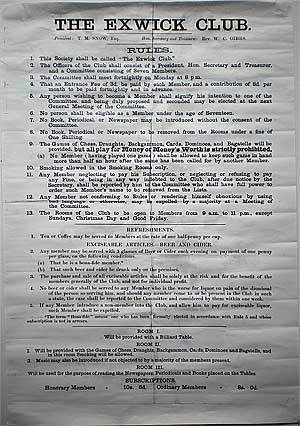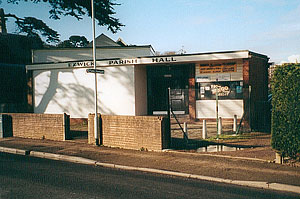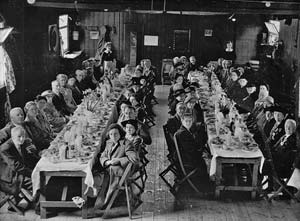
Exwick's Parish Hall
Researched and written by Julia Sharp
Page updated 15th January 2010
Exwick's Parish Hall dates, like many others, from just after the Great War. It was not the first venue for villagers to meet as there is evidence of the Exwick Club in the 19th Century, although where it was sited, and when it closed, is unknown.
After the war, many communities were conscious of the debt they thought was owed to the returning soldiers, and the glorious dead, and Exwick was no different. Subscriptions were sought and a War Memorial was dedicated in June 1920. The balance of the War Memorial Fund was then used as the start of the fund to build the Institute, a club for ex-servicemen and a hall for the use of the village. By 28th November 1921 the balance, including interest, was £536. 0. 10d., some of which were repayable deposits.
Buller Estates let the Institute have a corner of a field next to the church, between Station Road and the leat, for a peppercorn rent of 5 shillings per annum. Ex-servicemen from the village assisted Mr. Tom Fursman, a local builder, in constructing a wood lined, corrugated iron building, which cost £450 for materials and labour. It was very similar to the many 'kit built' tin-tabernacles that had sprung up all over the country in the late 19th Century. The entrance to the Institute, as it was then known, was from the lane opposite the Lamb Inn, which ran alongside the leat. A partition was installed to enclose 20ft. of length arranged to make a cosy room for the club, and to enable the rest of the building, or ‘The Minor Hall’ to be used without inconveniencing the club members. This could be dismantled for dances and other functions.
The building was opened on Monday evening 19th December 1921, by Mr. S. C. Snow.
The 1930s
1933 was a landmark year. On 6th June there was a fire which appears to have gutted the interior but not affected the exterior. The cause was most probably the gas lighting, as electricity was installed during the reconstruction. The effects were felt for some time, as in 1938 there was mention of the use of the base of the parallel bars partially destroyed by the fire being granted to the Boys Brigade for use on drill nights. By the end of 1933, all the deposits had been repaid. It was therefore decided that the Institute should be handed over to the parish on 19 December 1933, the twelfth anniversary of the opening. The committee were also able to hand over £132 18s 4d., together with a building which they said was ‘in first class condition both inside and out.’
We seem to think of bad behaviour as a 21st Century problem, but there are several references in the committee records of having to discipline members during the whole of the 20th Century. Within a few months of the club opening, they had to close it on Saturday afternoons due to the unruly conduct of some members. People were expelled in every decade until the club closed in 1952.
Initially there was no kitchen, so in 1935 a sectional hut was purchased for this purpose and was placed just outside the front doors of the building. This was the first of a number of additions, including a Nissen hut about 1947, used as a club room as well as a new kitchen, which required more land. Buller Trustees agreed to this, but doubled the ground rent to 10 shillings per annum.
Another war
The first indication of a coming war was the use in 1938 of the Minor Hall by Malletts Mill Air Raid Precaution Committee for two series of lectures.
One incident during the war that involved the Institute was the fire at the County Steam Laundry on 2nd December 1941, when the top floors of the laundry were gutted. The Minor Hall was let to the laundry for sorting clothing and linen, although it had to be cleared on Thursday evenings, for use by the Boys Brigade. This was a temporary measure and lasted about six weeks.
During 1943 chairs and tables were used for the American teas at the vicarage, with an offer to use the Institute if wet. It is known that GIs were stationed nearby, as there is anecdotal evidence of their interaction with the local youth and meetings at the Thatched House with land girls staying at Cleve House.
In 1952 the land on which the Institute stood was purchased for £50, having been sold as part of Hamlyns Farm. Then in 1967 the field adjoining the Institute was acquired for £350, giving the committee the opportunity, in 1969, of moving the entrance to Station Road, and at the same time, an additional extension with kitchen. Additionally the name was changed to Exwick Parish Hall. In 1974 the leat was culverted and the land created was given equally to the houses in Exe View Cottages and the hall. South West Water also gave some additional land, from the allotments, together with a sum of £450. In 1980, Downes Estate approached the committee about the old sheds at the rear of the hall, from which the occupiers were to be evicted before they were sold. The committee offered £450 for the land and sheds, which was accepted, and arranged for the gates to be moved to include the new land.
The Coronation 1953
The Institute staged an elaborate celebration for the Coronation of Queen Elizabeth II on 2nd June 1953. A special committee was set up after a public meeting and they started work nine months before the event. It was agreed that persons eligible for invitation would be those living in Exwick between the Thatched House and Weircliffe, as well as persons living outside the parish who took an active part in parochial affairs. Hill Palmer and Edwards was asked to supply the food. On the day there were 432 paying adults, 34 pensioners (who had the meal at home) and 165 children. One person received a refund as he had been called up for National Service. Exeter City Council agreed to the use of the pleasure ground, but originally refused to close Station Road but then indicated that if it was under repair, it would be closed anyway. The day was full, commencing with a church service and ending with alfresco dancing.
Much discussion had taken place since the change of the entrance to Station Road about the need for a suitable front wall, rather than the link fence that had not proved very successful. In 1987 the Manpower Services Agency agreed to build a brick wall, as well as undertaking some work on the car park
During the whole of the life of the Institute and hall there had been much comment on the lack of commitment from the parishioners. Year after year, the vicar or other president of the Annual General Meeting had remarked on the low attendance at the AGM. However in 1988 things came to a head. At this AGM a number of long term officers expressed the wish to retire and it was only possible to elect nine committee members, three short of a full committee. This was rectified at a further meeting at which it was reported that the trustees had been advised the hall should register with the Charity Commission as a charity. The hall was duly registered on 11 July 1989, and became a charity under a scheme signed and sealed on 31st July 1990. The new objectives were the provision and maintenance of a village hall for the use of the inhabitants of the electoral ward of Exwick rather that the ecclesiastical parish. When it became a charity, the renamed Exwick Parish Hall became independent of the church and is now governed by the trustees and committee.
Best run Village Hall
In 1989 the committee entered the hall in a competition for the best run village hall and came second. They continued to enter for some years and were also second in 1990 and 1991. There was no competition in 1993 and in 1994 the hall received £75 and a certificate as a ‘Special Award’ for catering for all aspects of the community.
During the 1990s, the hall continued to operate and the committee renovated the kitchen before looking again at extending the hall. The Christian Fellowship became a long-term user. The vandalism continued and increased with reported threats to playgroup leaders, and a threat from local youths to wreck the Parish Hall. The proposal to have a new Community Hall in Kinnerton Way was mooted, and talks took place with representatives of Exeter City Council, but this would not come to fruition until in the 21st Century.
During the whole of the 20th Century the hall had been at the centre of life in the village. Many people had their wedding receptions, and birthday parties here. The club offered a place for the men to meet for, among other things, billiards, music and to read selected magazines. Whist drives and dances were held organised by cricket, football, and other bodies. Women’s Institute, Boys Brigade, Girl Guides and many other bodies met. school medicals and lunches were held.
In the current century, the hall has continued to evolve to offer the residents of Exwick a good place for them to meet, either at weekly events such as the long established Over 60s Club and Bingo, or the Exwick Ark and Exwick Community Church. Long may this continue to allow the ‘Old Tin Hut’ to celebrate its centenary.
Sources: Minutes of the Committee Meetings for the Club and Hall since 1921.
 Poster for the Exwick Club -
circa 1880. Click to enlarge.
Poster for the Exwick Club -
circa 1880. Click to enlarge.
Exwick's Parish Hall
from Station Road. Photo Alan H Mazonowicz.
 The 1953 Coronation Tea
Party in Exwick's Parish Hall. Click to enlarge.
The 1953 Coronation Tea
Party in Exwick's Parish Hall. Click to enlarge.
│ Top of Page │